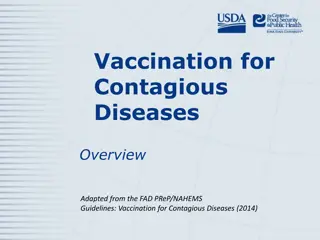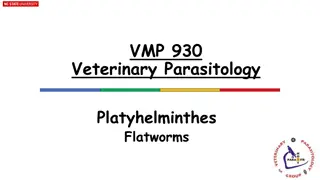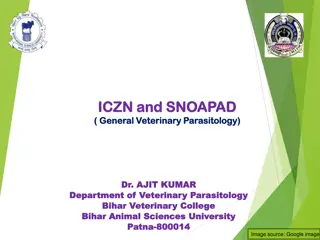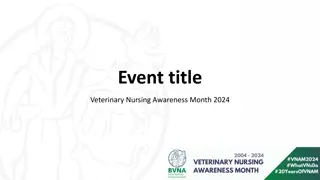Understanding Tapeworms in Veterinary Parasitology
This comprehensive guide delves into the world of cestodes, focusing on tapeworms. From the general characteristics of flatworms to the intricate life cycle of cestodes, including their presence in large and small animals, this resource provides valuable insights. Explore the morphology of different tapeworm species, their complex life cycles involving definitive and intermediate hosts, and the zoonotic potential of certain tapeworms. Dive deep into the detailed descriptions of Taenia spp. found in pets, such as Taenia pisiformis in dogs. The visual aids accompanying the text offer a clear understanding of tapeworm anatomy and stages. Gain knowledge on identifying and managing tapeworm infestations in veterinary practice.
Download Presentation

Please find below an Image/Link to download the presentation.
The content on the website is provided AS IS for your information and personal use only. It may not be sold, licensed, or shared on other websites without obtaining consent from the author. Download presentation by click this link. If you encounter any issues during the download, it is possible that the publisher has removed the file from their server.
E N D
Presentation Transcript
VMP 930 Veterinary Parasitology Cestodes Tapeworms
Cestodes Tapeworms General Flatworm Characteristics Except lacks Digestive Tract Absorbs food directly across Tegument Adult Body Scolex => Holdfast organ Usually has suckers, retractable or non-retractable rostellum of hooks Neck Germinative region produces "segments , asexually Strobila Series of Maturing "Segments" or Proglottids Immature, mature, gravid proglottids in series Each Proglottid is an individual reproductive unit
Scolex & Neck Taenia sp.
Immature Proglottids Taenia sp.
Mature Proglottids Genital pore Testes Yolk gland Ovary Taenia sp.
Gravid Proglottid Uterus packed with eggs Genital pore Taenia sp.
Cestodes Complex Life Cycle Definitive Host Adult Worms Sexual Reproduction Ova 1 or 2 Intermediate Hosts Larval tapeworms Metacestodes various types depending on species Some show Asexual Reproduction Cysticercus bladder worm
Cestode Groups Large Animals Small Animals Adult Tapeworms Anoplocephala (equine) Moniezia (ruminants) Adult Tapeworms Taenia pisiformis (dogs) Taenia taeniaformis (cats) Echinococcus granulosus (dogs) Dipylidium caninum (dogs, cats) Spirometra sp. (dogs, cats) Larval Tapes (condemnations) Taenia saginata (cattle) Taenia solium (swine) Human Zoonosis Adult Tapeworms Taenia saginata Taenia solium Dipylidium caninum Human Zoonosis Larval Tapeworms Echinococcus sp. Taenia solium Spirometra sp.
Taenia spp. of Pets
Taenia pisiformis Large tapeworm of dogs Scolex with non-retractable armed rostellum and 4 suckers Strobila (up to 6 ft long) made of rectangular proglottids with single irregularly alternating unilateral genital pores Life Cycle DH: Dogs, fox, coyote, wolf (small intestine) Gravid proglottids passed in feces Ova disseminated in environment IH: Rabbits or Squirrels Cysticercus larvae (bladder worm) in liver and mesenteries. Ingested by the Definitive host Worldwide Not Zoonotic
Taenia pisiformis Pathology, Diagnosis No Pathology (maybe nutrient competition in malnourished hosts) "Client Worry (proglottid aesthetics) Active Segments on Poop or Pet Clinical Signs Segments presented by Client Pet usually shows no signs Occasionally dog drags tail Dietary History -- possibility of rabbit diet Diagnosis Segment Squash Rectangular segment Single Spherical eggs with striated shell.
Taenia pisiformis Treatment, Control How would you prevent re-infection? Praziquantel (Droncit) (5mg/kg) Pyrantel+Praziquantel+Febantel (Drontal Plus Tablets) Pyrantel+Praziquantel (Virbantel Flavored Chewables) Ivermectin+Pyrantel+Praziquantel (Iverhart Max Chewable Tablets) Epsiprantel (Cestex) (5.5 mg/kg) Fenbendazole (Panacur) (50 mg/kg SID for 3 days) (Praziquantel & epsiprantel are the drugs of choice for tapeworms.) Restrict access to Rabbits
Taenia taeniaformis Large tapeworm of cats Scolex with non-retractable armed rostellum and 4 suckers Strobila (up to 2 ft long) made of rectangular proglottids with single irregularly alternating unilateral genital pores Worldwide Not Zoonotic Life Cycle DH: Cats, Lynx (small intestine) Gravid proglottids passed in feces Ova disseminated in environment IH: Rodents Strobilocercus larvae in liver. Ingested by the Definitive host Treatment Praziquantel (Droncit) Pyrantel+Praziquantel (Drontal tablets) Emodepside+Praziquantel (Profender) Pathology No Pathology (maybe nutrient competition in malnourished hosts) "Client Worry (proglottid aesthetics) Epsiprantel (Cestex) Fenbendazole (Panacur) [extra-label] Clinical Signs Segments presented by Client Pet usually shows no signs Occasionally cat drags tail Dietary History -- possibility of rodent diet Diagnosis Segment Squash Control ?? Rectangular segment Single Spherical eggs with striated shell. Restrict access to Rodents
Taenia spp. of Humans
Taenia saginata Beef tapeworm of humans Worldwide 24 to 75 ft long, survives many years Larval tapeworms in cattle Control ? Restrict human defecation in cattle pastures. Restrict human from eating raw beef. USDA condemnation of "Measly beef". USDA guidelines for cooking beef. Life Cycle DH: Humans (small intestine) Gravid proglottids passed in feces IH: Cattle Cysticercus bovis (bladder worm) in muscles. Ingested by the Definitive host Pathology Human (DH) Proglottid aesthetics Nutrient competition in malnourished hosts Cattle (IH) Cysticercus bovis: Muscle & Heart damage Beef Condemnation ("Measly Beef") [economic loss] Diagnosis Human (DH) Tapeworm in feces Cattle (IH) - Cysticercus bovis @ slaughter Measly Beef 18 ft from raw-beef eater Treatment Human (DH) Niclosamide Cattle (IH) - Cysticercus bovis control measures
Taenia solium Pork tapeworm of humans Worldwide 15 to 24 ft long, survives 25 years Larval tapeworms in swine Treatment Human (DH) Niclosamide Cattle (IH) - Cysticercus cellulosae control measures Life Cycle DH: Humans (small intestine) Gravid proglottids passed in feces IH: Swine [humans] Cysticercus cellulosae (bladder worm) in muscles. Ingested by the Definitive host Control ? Restrict human defecation in swine pastures. Restrict human from eating raw pork. USDA condemnation of "Measly pork". USDA guidelines for cooking pork. Pathology Human (DH) (adult tapeworm) Proglottid aesthetics Nutrient competition in malnourished hosts Swine (IH) & [humans] Cysticercus cellulosae: Muscle damage Pork Condemnation ("Measly pork") [economic loss] Measly Pork Diagnosis Human (DH) Tapeworm in feces Swine (IH) - Cysticercus celulosae @ slaughter
Taenia solium -- Cysticercosis Larval pork tapeworm in humans Very Important Pathogenic Human DZ Most important cause of neurologic DZ in Latin America Humans as intermediate hosts. HOW ? cysticerci in muscles, eyes, brain. Neural Cysticercosis If humans ingest ova from human feces; then cysticercosis.
Echinococcus granulosus Minute tapeworm of Canids Sporadic distribution Larval tapeworms in various animals & humans Major Zoonotic concern Diagnosis Dog (DH) Tapeworm or Ova in feces Various IH Hydatid Cyst @ slaughter - Serology, Radiographs - Humans : CDC has ELISA to distinguish between the two species found in humans. Life Cycle DH: Dogs, Wild Canids (small intestine) Gravid proglottids passed in feces IH: various ruminants & swine [humans] Hydatid Cyst in various organs Ingested by the Definitive host Treatment Canid (DH) Praziquantel, Epsiprantel Various (IH) - Aggressive Mebendazole or Albendazole Pathology Canids (DH) No Pathology Various (IH) & [humans] Hydatid Cyst DZ Organ damage Pressure atrophy Risk of anaphylaxis if cyst ruptures Control Restrict canine access to ruminant pastures. Do not feed canids uncooked offal Regular deworming of dog Eliminate stray or wild canids
Geographic Distribution Sporadic Global Distribution E. granulosus E. multilocularis
Echinococcus spp. Hydatid Cyst DZ Larval tapeworm in various animals Multilocular Cyst in Cow Liver Unilocular Hydatid Cyst Multilocular Cyst in Horse Liver Multilocular Cyst in Vertebra
Echinococcus spp. Hydatid Cyst DZ Larval tapeworm in Humans Very Important Zoonotic DZ Humans act as intermediate hosts. HOW ? Hydatid Cyst in Liver, Lungs, Brain. If humans ingest Echinococcus ova from dog feces; then Hydatid Cyst DZ Hydatid Cyst DZ
To Contemplate is to Exercise the Intellect To Contemplate is to Exercise the Intellect If you choose; contemplate the following in the mirror : If you believe: My group is the sum of all good in the world. My group represents the highest aspirations of humankind. So, my group s interest is the universal interest. And if anybody threatens my group; they threaten virtue, then I have warrant for [bullying]. By [bullying] them I am protecting virtue. Professor Stephen Reicher Psychologist & Holocaust Scholar University of St. Andrews























